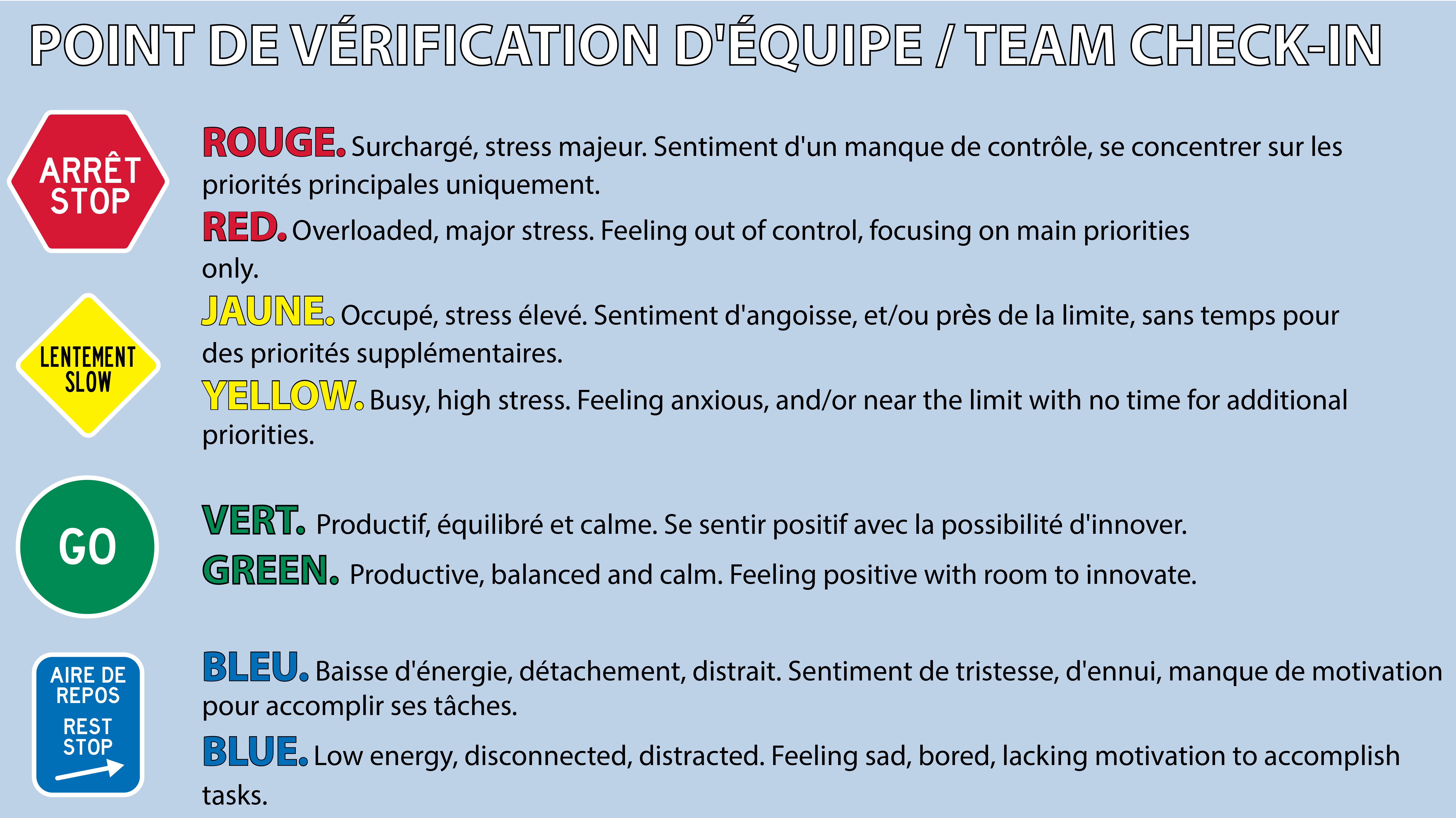Check-In Tool (Short Version)
Long Description
Arrét, Stop
ROUGE. Surchargé, stress majeur. Sentiment d'un manque de contrôle, se concentrer sur les priorités principales uniquement.
RED. Overloaded, major stress. Feeling out of control, focusing on main priorities only.
Lentement, Slow
JAUNE. Occupé, stress élevé. Sentiment d'angoisse, et/ou près de la limite, sans temps pour des priorités supplémentaires.
YELLOW. Busy, high stress. Feeling anxious, and/or near the limit with no time for additional priorities.
Go
VERT. Productif, équilibré et calme. Se sentir positif avec la possibilité d'innover.
GREEN. Productive, balanced and calm. Feeling positive with room to innovate.
Aire de repos, Rest Stop
BLEU. Baisse d'énergie, détachement, distrait. Sentiment de tristesse, d'ennui, manque de motivation pour accomplir ses tâches.
BLUE. Low energy, disconnected, distracted. Feeling sad, bored, lacking motivation to accomplish tasks.
This tool is for…
What: A team check-in exercise that explores each person’s current mental/emotional state in relation to their work
Who: All team members
Why: To promote connectedness amongst team members; to take note of and provide resources to team members who are struggling
When: At the beginning of team meetings
Team Check-In: Guidance
This is a simple check-in tool to get a sense of how the team is coping in both their work and personal lives. It helps develop individual self-awareness of what "zone" each person is in. By sharing as a group, it gives team members insight into how their colleagues are doing, and builds our collective capacity to see the world through another person’s eyes so that we may take appropriate steps to support one another.
To Use:
- Open the meeting and share the image. Ask the team to take a moment to reflect on which colour represents their current state.
- Invite people to share what is comfortable to them – emotions and feelings might be accessible to some, others may prefer to stay focused on their capacity for work. People might identify as being between colours or a mix of several, which is normal and worth exploring. There is no right or wrong way to answer.
- If it’s your first time doing a team check-in, it can be good to lead by example and as leader, share how you’re doing. This makes it safe for others, and creates a sense of "equality": everyone has feelings, good days and challenging days, including leaders!
- Consider asking team members if they need anything in order to manage their own "zone". This can create opportunities for offers of mutual understanding and assistance within the team.
- Close the exercise by thanking everyone for their openness. Remind people that whatever they are feeling, it is normal, and that you are available for private follow-ups (not everyone will be comfortable asking for more help in front of the group).
What to listen for:
- Sharing as a team might allow some work re-distribution: someone feeling more "green" might be able to support someone experiencing orange or red.
- Watch for employees who may be "stuck" in a challenging zone over multiple check-ins. Are there opportunities to better align an employee’s work with current skills, and aspirations for growth and development? Could they benefit from accessing other supports?
- If there are reoccurring themes of concern, consider the use of a Talking Circle and/or Laser Coaching.
Resources: What to do if an employee has identified they are struggling?
- As leaders, it is important to follow-up with those who report that they are struggling (closer to either red or blue). This active listening tool may help with that conversation.
- During the conversation, employees may express interest in additional supports. Below are several resources that are accessible on the internet, tailored to different needs.
- External Webpage for ESDC employees: Stay up to date with DM messages and resources
- Employee Assistance Program (EAP): access to trained counsellors
- LifeSpeak: self-serve, online tools, resources and practices
- Mental health tips for working from home
- COVID-19 and Mental Health @ Work
- Coronavirus (Covid-19): Take care of yourself infographic
- eMentalHealth.ca: Find mental health help in your area
- OICM – for confidential consultations, Laser Coaching, Talking Circles, and other services: ph. 1-866-382-7502; NC-OICM-BGIC-GD@hrsdc-rhdcc.gc.ca
